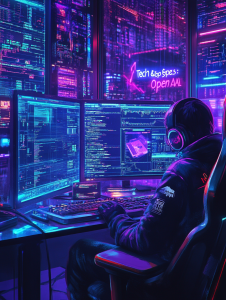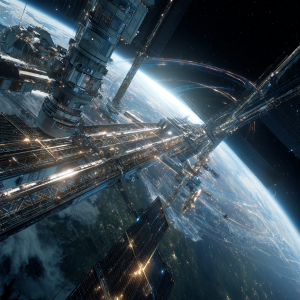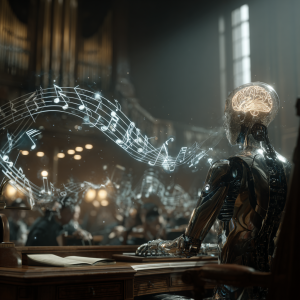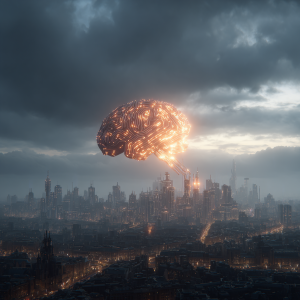They built the bot that’s now helping you write emails, solve code, and question your career choices at 2 a.m. Meet OpenAI—the AI powerhouse with a mission to save humanity (or at least not accidentally doom it). From ChatGPT to DALL·E, they’re changing how we interact with technology, one uncanny conversation at a time. In this post, we peek behind the curtain of Silicon Valley’s most talked-about brainiac.
Note from the Author
When I first dipped my toes into the world of AI, one question kept popping up: Who are the actual brains (and wallets) behind this revolution we’re all suddenly living in? With everyone talking about “AI this” and “GPT that,” I wanted to know who’s steering the ship—and whether we should be impressed, concerned, or both. This series was my way of getting some clarity, and dragging you lovely readers along for the ride.
Over five articles, I take a closer look at the titans of today’s AI boom—from Silicon Valley superstars to under-the-radar giants quietly reshaping the world. I didn’t write this just for tech experts or lawyers—I wrote it for everyone who’s ever asked, “Wait, who actually builds this stuff?”
As someone standing between law, tech, and a healthy dose of curiosity, I believe it’s time we all know a bit more about the companies shaping our future—before they finish training the next model to replace us in meetings.
And no, this isn’t the end. There are many more fascinating players out there, and I fully intend to hunt them down (figuratively) and tell their stories too.
So buckle up, grab a snack, and let’s meet the powerhouses behind the code.
From Research Lab to World Domination (With a Friendly Face)
Founded in December 2015, OpenAI was initially the brainchild of a bunch of Silicon Valley legends who decided to join forces and not build the next social media app (refreshing, right?). The co-founders included Elon Musk, Sam Altman (our current CEO and Mr. Calm-in-the-Storm), Ilya Sutskever (deep learning genius), Greg Brockman (former CTO of Stripe), and others. Their mission? To ensure that artificial general intelligence (AGI)—you know, super-smart AI that could theoretically outthink Einstein, your law professor, and your mum’s life advice—all benefits humanity.
OpenAI started as a non-profit with a “we’re doing this for the good of the world” vibe. But by 2019, the scale and cost of developing advanced AI models got… well, spicy. So, they introduced a “capped-profit” model through OpenAI LP, allowing them to take on investors without turning into a corporate villain in a Marvel movie. Enter Microsoft: they slid in with a $1 billion investment in 2019 and later pumped in more, becoming OpenAI’s biggest sugar daddy—err, partner.
OpenAI’s core playground is artificial general intelligence, large language models, reinforcement learning, and systems that can (almost) think, write, code, and create like humans. They are the proud parents of ChatGPT, Codex, DALL·E, Whisper, and GPT-4. It’s a family of overachievers.
What OpenAI Does
Let’s be honest—if you’ve ever had a “deep” conversation with an AI about whether pineapple belongs on pizza, it was probably with ChatGPT. But OpenAI’s magic goes far beyond small talk.
The Big Names in the OpenAI Universe:
- GPT-4 (Generative Pre-trained Transformer): The big kahuna. Trained on oodles of data, GPT-4 can generate, summarize, translate, and explain text like a high-functioning polyglot with a caffeine addiction. Lawyers use it to draft memos, coders to debug their spaghetti code, and students to write “original” essays.
- DALL·E: Turns your weirdest thoughts (“a corgi dressed as a judge in space court”) into artwork. It’s like having Picasso on standby—minus the ego.
- Codex: The coder’s BFF. It powers GitHub Copilot and writes code in a dozen languages. Also capable of helping you automate tedious tasks like writing out Excel macros. We stan.
- Whisper: An automatic speech recognition (ASR) system. Think of it as the AI who’s always taking perfect notes, even when the mic quality is garbage.
But OpenAI isn’t just about churning out cool tools—they’re obsessed with aligning AI systems with human values. That’s where their research on reinforcement learning with human feedback (RLHF) comes in. Basically, they teach AIs to be less weird by giving them feedback, just like you’d train a golden retriever not to steal socks.
Why OpenAI is (So) Successful: What’s Their Secret Sauce?
Besides having Microsoft’s billions and an army of top-tier researchers, OpenAI plays the game differently:
1. They Build Big, Bold, and Open (ish)
OpenAI shocked the world with GPT-2 in 2019—not by releasing it, but by initially refusing to do so. They claimed it was “too dangerous.” Marketing genius? Probably. But it sparked real conversation about responsible release strategies in AI. Fast-forward to GPT-3 and GPT-4, and they’ve set the tone for how to scale, deploy, and govern frontier models.
2. Developer First, Policy-Aware
From APIs to partnerships, OpenAI has prioritized developer tools and ease of use. But they’re not cowboys—they actively engage with policymakers, ethicists, and researchers to debate AI safety, alignment, and fairness.
3. They Are the Cool Nerds of AI
OpenAI has built a reputation that’s part cutting-edge research lab, part meme. They’re scientific, strategic, and just rebellious enough to keep the AI world spicy. Remember the drama with Sam Altman’s temporary firing and dramatic return? It was like a season of Succession, but with more Python scripts.
Real-World Impact: How OpenAI Is Already Shaping Our Lives
For all the futuristic talk around OpenAI, this isn’t just a story about sci-fi scenarios or academic breakthroughs. OpenAI’s work is already quietly (and not-so-quietly) infiltrating daily life—and whether you’re a student, CEO, programmer, or just someone trying to remember the difference between “affect” and “effect,” chances are, OpenAI’s models have touched your life.
In Education
Students across the globe are using ChatGPT to help with research, essay drafts, language practice, and, let’s be honest, procrastination in style. Teachers are using it to create lesson plans, quizzes, and even personalized tutoring material. It’s like a free teaching assistant… with perfect grammar and no need for coffee breaks.
In Business
From generating marketing copy to summarizing reports, OpenAI’s tools are saving time and boosting productivity. Major companies like Morgan Stanley, PwC, and Duolingo are building OpenAI-powered features directly into their workflows. Need a polished email? A first draft of a legal memo? A script for your YouTube ad? There’s a bot for that.
In Coding
OpenAI’s Codex, especially via GitHub Copilot, is revolutionizing software development. Programmers are using it to autocomplete functions, fix bugs, and learn new languages on the fly. Some say it’s the new Stack Overflow… others say it is their co-pilot on days when brain fog kicks in before lunch.
In Creativity
Artists and writers are co-creating with DALL·E and GPT-4—whether for graphic novels, concept art, or quirky birthday cards. Creatives are using AI to brainstorm, prototype, and iterate at lightning speed. Yes, your next poem about heartbreak and tacos might just have a little AI help.
In Healthcare & Law
Whisper (OpenAI’s speech recognition model) is being used for medical transcription and real-time translation in hospitals. Lawyers are using GPT-powered tools to sift through contracts, draft NDAs, and even simulate courtroom arguments. The robot lawyer isn’t quite ready for its bar exam, but it’s definitely doing paralegal work on the side.
OpenAI’s impact is like electricity: quiet, everywhere, and a bit dangerous if you don’t understand it. It’s already embedded in apps, tools, and decisions that affect how we learn, work, create, and even govern.
So the question is no longer “Should we use AI?”
It’s “How do we use it wisely—and who gets to decide?”
Final Thoughts
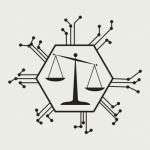
OpenAI is more than just the company that made ChatGPT your new therapist/copywriter/IT guy. It’s a vision machine—a team trying to steer the AI rocket ship before it crashes into dystopia or becomes another ad-serving tool for sneakers.
By marrying hardcore research with public-facing tools, OpenAI has built a unique bridge between academic AI and the real world. Whether that’s for better or worse… well, we’ll find out soon enough.
One thing’s for sure: in the story of artificial intelligence, OpenAI isn’t just a chapter. It’s a whole plot twist.
Stay curious, stay informed, and let´s keep exploring the fascinating world of AI together.
This post was written with the help of different AI tools.

